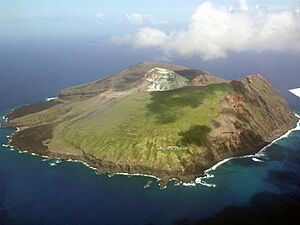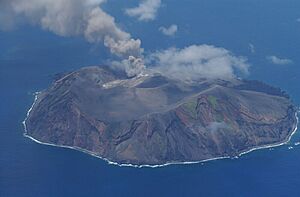Tori-shima (Izu Islands) facts for kids
|
Native name:
鳥島
|
|
|---|---|

Tori-shima, aerial photograph, 2001
|
|
 |
|
| Geography | |
| Location | Izu Islands |
| Coordinates | 30°29′02″N 140°18′11″E / 30.48389°N 140.30306°E |
| Archipelago | Izu Islands |
| Area | 4.79 km2 (1.85 sq mi) |
| Coastline | 6.5 km (4.04 mi) |
| Highest elevation | 394 m (1,293 ft) |
| Administration | |
|
Japan
|
|
| Prefecture | Tokyo |
| Subprefecture | Hachijō Subprefecture |
| Demographics | |
| Population | 0 |
Tori-shima (Japanese: 鳥島, Hepburn: Tori-shima) 'Bird Island', also known as Izu-Torishima (Japanese: 伊豆鳥島, Hepburn: Izu-Torishima) 'Bird Island of Izu Province', is an island in Japan. It is located in the Pacific Ocean and has no people living on it. This volcanic island is part of the Izu Islands.
Contents
Discovering Tori-shima: A Volcanic Island
Tori-shima is about 600 kilometers (370 miles) south of Tokyo. It is also about 76 kilometers (47 miles) north of a tall rock called Lot's Wife. The island is shaped like a circle.
Tori-shima's Volcano: An Active Giant
The Japan Meteorological Agency calls Tori-shima a Class A active volcano. This means it is a very active volcano. The island is actually the top part of a huge underwater volcano. The part of the volcano under the water still erupts. The last time the island's volcano erupted was in 2002. This eruption came with many small earthquakes.
Island Features: Mountains and Size
The main mountain on Tori-shima is called Iō-yama (硫黄山). It is 394 meters (1,293 feet) tall. The island's edge, or coastline, is about 6.5 kilometers (4 miles) long. The total area of the island is 4.79 square kilometers (1.85 square miles).
Tori-shima's Past: Shipwrecks and Settlements
Japanese sailors and fishermen knew about Tori-shima a long time ago. This was even before the Edo period began. No one lived on the island, except for people who were shipwrecked there.
Famous Shipwreck Survivors
In 1841, a 14-year-old boy named Nakahama Manjirō and four friends got shipwrecked on Tori-shima. An American whaling ship, the John Howland, rescued them. The ship was led by William H. Whitfield. A Japanese writer, Akira Yoshimura, found out about 15 other times people were shipwrecked there.
Early Settlements and Bird Harvesting
People started living on the island in the Meiji period. They mainly collected guano, which is bird droppings. This was because many short-tailed albatross birds used the island to build their nests. People also hunted these albatrosses for their feathers.
A businessman named Han-emon Tamaoki was very important in this. He arrived on Tori-shima in 1886. The next year, he started his company, Tamaoki Shokai. He collected feathers in a planned way until 1922. It is thought that about 5 million birds were killed. This almost made the short-tailed albatross disappear completely.
Volcanic Eruptions and Island Life
A big volcanic eruption happened in 1871. In 1898, the island became part of the Ogasawara islands. Then, in 1901, it moved to the control of Hachijojima. In 1902, a major volcanic eruption killed all 150 people living on the island. Tori-shima has been empty ever since.
Protecting the Island: Research and Conservation
Since the 1930s, the Yamashina Institute for Ornithology has worked hard to study and protect the seabirds on the island. They especially focused on the short-tailed albatross. By 1933, there were only about 50 of these birds left.
The Japan Meteorological Agency built a weather station and a volcano research station in 1947. But they had to leave in 1965 because of volcanic activity and earthquakes.
On November 1, 1954, Tori-shima became a protected bird sanctuary. On May 10, 1965, it became an even more protected national Natural monument.
Visiting Tori-shima: A Special Place
Only research scientists with special permission can visit Tori-shima. It is very hard to land on the island. This is because the sea is often rough, and there are no good beaches or places to dock.
Tour boats take people around the island to see the birds. These tours are popular, but they are not allowed to land on the island. Researchers usually travel to the island by a special government helicopter.
Tori-shima is officially part of Tokyo Metropolis, just like the other Izu Islands. It is also inside the Fuji-Hakone-Izu National Park.
Wildlife on Tori-shima: Plants and Animals
Repeated volcanic eruptions in 1939 and 2002 have changed the plants on Tori-shima. The island's plant life is starting over.
Plants of Tori-shima
You can find plants like Vitex rotundifolia and hydrangea near the shore. Chrysanthemum pacificum and Japanese black pine grow in areas that are more protected inland. But most of the middle of the island is still just volcanic ash and rock.
Birds and Other Animals: Life Cycle and Reproduction
The island is home to tens of thousands of Tristram's storm petrel pairs that nest there. Other birds include Japanese murrelet, black-footed albatross, common kestrel, and blue rock thrush.
The short-tailed albatross population has grown back very slowly. This is partly because there are many black rats on the island. Black rats are the only mammals left there.
Humpback whales and dolphins often swim around the island. They appear during their migration and breeding times. Tori-shima is the main place where short-tailed albatrosses breed. It is one of only two such places left. BirdLife International has called the island an Important Bird Area (IBA).
See also
- List of volcanoes in Japan
- List of islands of Japan
- List of islands
- Desert island



